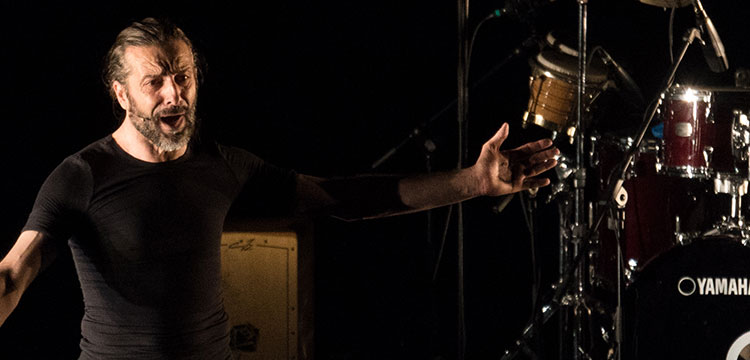José Manuel Gómez Gufi
The world premiere of “Yo le Canto a mi Baile” began unceremoniously with the house lights on. The dancer looks towards to the audience directly in the eyes, seated on a box that bears the sign: “Not for Sale”. A few more clues until he exhales short of breath: “This is a marathon” and seated before a music-stand he reads a manifesto:
“I sing for my dance, resonance of my body. Vibration in harmony, struggle with my emotions fighting an internal battle. Echo in my retina of movement in my memory, song in my fingers and my mouth. A child’s game and music in my ears. Will I be free some day? Will my delirium become calm? A stroke of punishment that resounds silently in my bones with a hidden dance”.
Andrés Marín sings, and he sings quite well. But to fill a stage with his choreography requires an effort that enters into a category that is nearly sport. Here the lighting of the Voluble Benito Jiménez plays a fundamental part within the sober play of lights and shadows in black and white. Andrés Marín dances in a contemporary style and what he sings is flamenco, although you’re not really sure if he meets all the rhythmic requirements of the forms he sings.
Two musicians back him up, guitarist Raúl Cantizano and Daniel Suárez on percussion which, at times is perfectly synchronized with the dancer, revealing much rehearsal and/or an agreement for certain choreographies when footwork and heels mark the same rhythm that might be bulerías, but of course what Marín dances might not be bulerías.
The percussionist sits with his cajón with his back to the audience, and we’re left wondering; Marín offers no further clues than those mentioned, and Cantizano plays bits of flamenco, giving the impression that they’re playing with a puzzle in which, as if in a dream, flamenco and the contemporary are mixed, occasionally coming together, and occasionally not. The abstract and/or surreal games play themselves out in small details, eyes painted on hands, a veiled face, two knives. The beauty of the work gradually wins over the attentive audience, and at one point the dancer takes advantage to recover from the effort. Cantizano interprets a composition of the sort included on his record “Mito y Geologíá del Canti”, and just when it seems everything is coming out nicely for common mortals (whether flamingos or pelicans), he puts the electric guitar to one side to allow Andrés to dance a zapateado to the buzzing, and the electric guitar passes from musical instrument to knick-knack.
It was just about then when techno (almost bacalao) began to sound, Andrés Marín unfolded a Spanish flag with the silhouette of a bull and began to amble around the stage as if he were an imitator of skater Javier Fernández at a discotheque. “Long live the real Spain!” they shout, and one is surprised with a bad aftertaste.
It comes to an end, they bow and Andrés thanks us for having shared his paranoia. No problem, that’s what we’re here for.
LOS VOLUBLE
Shortly before Marín’s debut, Los Voluble interpreted “Flamenco is not a Crime”, and when this journalist went into the performance space, there was Lola Flores projected on the screen while a bunch of shadows compulsively moved their heads to the rhythm of a contemporary beat. Nothing the Voluble does is original, everything is copied, from the title (taken from the recent exhibit “El Graffitti no es un crimen”) to the T-shirts.
What makes the Voluble necessary is the combination of all the elements. A huge bunch of images from Holy Week or “Rito y Geografía del Cante”, dancing to the rhythm of whatever is fashionable, and if Rosalía and la Periñaca also appear together in rhythm, all the better.
I haven’t closely followed the latest tendencies in electronic music, but what makes the Voluble popular isn’t the latest, nor the most modern, and between shadows and head-bopping there are a lot of followers on the verge of ecstasy with the mix, which contained nothing flamenco, in addition to the iconography and some samplers.
Nearly sold out. Like the Chirigota del Selu said: “it’s too much that you have to come to a chirigota carnival group to get a full house”.
Video:
Photos (MJ Lara):
